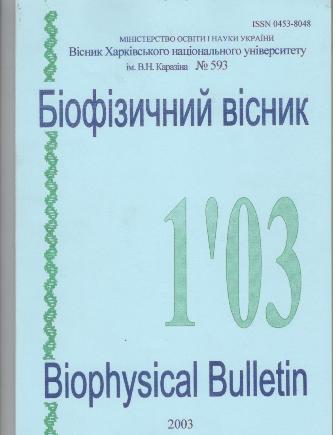Absorption and fluorescent properties of potential fluorescent probes of nucleic acids molecular hybridisation, based on phenazine derivatives
Abstract
Absorption and fluorescent spectra of imidazo-[4,5-d]-phenazine and its three novel derivatives were studied in ethylacetate and glycerole. Absorption spectra of these derivatives in visible region consist of two bands attributed to different ππ* electronic transitions. Energy values of S1<—S0 electronic transition are calculated for all derivatives. Fluorescence polarization degrees of 2-trifluoridemethylimidazo-[4,5-d]-phenazine and 1,2,3-triazole-[4,5-d]-phenazine are several times higher of that for unsubstituted imidazophenazine, that makes perspective their using as fluorescent probes upon studies of nucleic acid molecular hybridization.
Downloads
References
Van Rensburga CEJ, Joonea GK, Sirgelb FA. Chemotherapy. 2000;46:43-8.
Jana AK. J. Photochem. Photobiol. A: Chemistry. 2000;135:1-17.
Muller W, Crothers DM. Eur. J. Biochem. 1975;54:267-77.
Makitruk VL, Yarmoluk SN, Shalamay AS. Nucl. Acids Res. Symp. Ser. 1991;24:244.
Makitruk VL, Shalamay AS, Kondratiuk IV. Biopolimery i kletka. 1997;13(6):453-9. (in Russian)
Zarytova VF, Kutiavin IV. Bioorganicheskaia khimiia.1986;12(7):911-20. (in Russian)
Lokhov SG, Podyminogin MA. Bioconjugate Chem. 1992;3(5):414-9.
Zozulya V, Blagoi Yu, Lober G, Voloshin I. Biophys. Chem. 1997;65:55-63.
Blagoi Yu, Zozulya V, Voloshin I. Biopolimery i kletka. 1997;13(1):22-29. (in Russian)
Zozulya V, Shcherbakova A, Dubey I. J. Fluoresc. 2000;10(1):49-53.
VanAllan JA, Reynolds GA, Adel RE. J. Org. Chem. 1962;27:1659-64.
Temnikova TI. Kurs teoreticheskikh osnov organicheskoi khimii. L:GNTIKhL; 1962. 948p. (in Russian)
Gordon AJ, Ford RA. The Chemist’s Companion. New York-London-Sydney-Toronto:John Wiley & Sons; 1972. 541p.
Birks JB. Photophysics of Aromatic. New York:John Wiley & Sons; 1970. 704p.
Feofilov PP. Poliarizovannaia liuminestcentciia atomov, molekul i kristallov. M.:Fizmatgiz;1959. 288p. (in Russian)
Terenin AN. Fotonika molekul krasitelei i rodstvennykh organicheskikh soedinenii. L.:Nauka; 1967. 616p. (in Russian)
Aaron JJ, Maafi M, Parkani C, Boniface C. Spectrochim. Acta. 1995;54(A):603-15.
Nurmukhametov RN. Pogloshchenie i liuminestcentciia aromaticheskikh soedinenii. M.:Khimiia; 1971. 216p. (in Russian)
Authors who publish with this journal agree to the following terms:
- Authors retain copyright and grant the journal right of first publication with the work simultaneously licensed under a Creative Commons Attribution License that allows others to share the work with an acknowledgement of the work's authorship and initial publication in this journal.
- Authors are able to enter into separate, additional contractual arrangements for the non-exclusive distribution of the journal's published version of the work (e.g., post it to an institutional repository or publish it in a book), with an acknowledgement of its initial publication in this journal.
- Authors are permitted and encouraged to post their work online (e.g., in institutional repositories or on their website) prior to and during the submission process, as it can lead to productive exchanges, as well as earlier and greater citation of published work (See The Effect of Open Access).





